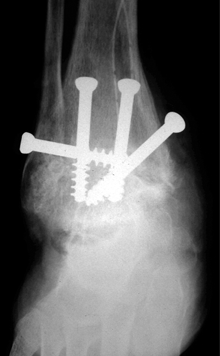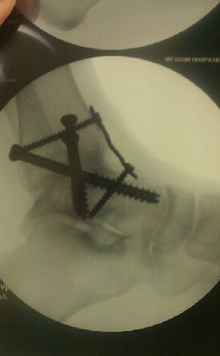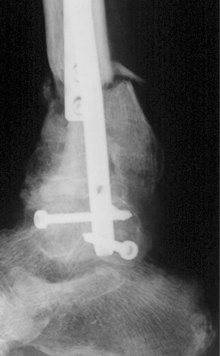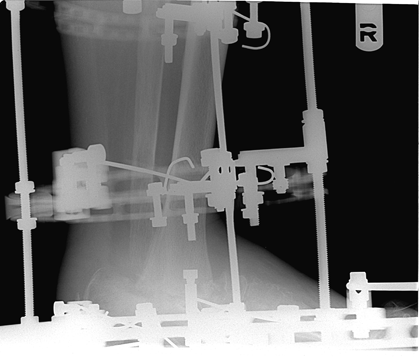(877) 977-1443
Conditions
- Ankle Arthritis
- Ankle Ligament Tear (Sprain)
- Ankle Fractures (Broken Ankle)
- Flat Feet
- Tarsal Coalition
Advanced Treatments
- Regenerative Medicine
- Ankle Arthroscopy
- Total Ankle Replacement
- Ankle Fusion
- Ankle Cartilage Replacement
- Custom Orthotics
- Physical Therapy
- Lifestyle Changes
Education and Articles
Trusted Podiatrists

Ankle Fusion/Arthrodesis
At Ankle Arthritis Institute, we do everything in our power to explore a patients' options before undergoing any surgical procedure. However, every patient case is different, and we will consult with each patient on what the best options are for them. Joint destructive procedures are reserved for severe end-stage arthritis of the ankle. Often patients will have no joint space or motion present and are in debilitating pain. Currently, joint destructive procedures are reserved for high strain patients who require a lot out of their ankles and are very active with high demand jobs. There is a misconception that ankle fusion is a bad procedure and there is a problem with limited motion.

Ankle fusion has historically been the gold standard treatment for severe end-stage. This is a joint destructive procedure is very successful and is performed by fusing the bones of the ankle together to eliminate any remaining painful motion. This procedure involves removing all the remaining cartilage in the ankle and then holding the two bones together in the proper position with hardware. A successful ankle fusion will allow patients to ambulate without pain. Often, little to no change in gait is noted after the fusion. Patients are often concerned that motion is lost to the ankle. However, with ankle arthritis, motion at the ankle is often already lost or restricted. The difference is that a successful ankle fusion allows the patient to ambulate without pain while a severely arthritic ankle can be very painful and limiting. Fused joints are very stable and can withstand heavy stress, especially compared to an implant. Therefore younger and more active patients with degenerative joint disease would benefit more from an ankle fusion rather than an ankle replacement.
The ankle surgeons at Ankle Arthritis Institute are truly one step ahead most podiatrists in the number of ankle fusion techniques used. While each ankle fusion surgery is tailored to a patients individual goals and condition, there are several types which are used successfully at Ankle Arthritis Institute.
Types of Ankle Fusion Techniques
Although ankle fusion surgery is the best treatment option for severe end-stage ankle arthritis, it is not a one-size-fits-all procedure. As a matter of fact, there are many different types of ankle fusion surgery, each one designed to address the specific needs of the patient. Here, we have X-rays of some the different procedures that may be used, depending on your individual needs.
The 3 screw method is the standard ankle fusion procedure. It is used for patients who have no additional issues that need to be addressed during ankle fusion surgery. The screws are very strong and add bone on bone fixation. With the addition of bone marrow aspirate stem cells, bone healing is accelerated and fixation is kept to a limited amount to allow better bone on bone contact.
 3 Screws
3 Screws
Multi-screw procedures use more screws than the standard procedure. This is most often seen in patients who need the additional support because of weight-bearing concerns, patients with poor bone quality, or patients who are large or over-weight. The additional screws allow for more solid fixation and possibly earlier weight bearing. The downside can be less bone on bone contact from the multiple screws. With the addition of bone marrow & stem cell concentrates, this type of fusion has been highly successful for us.
 Multi-Screws
Multi-Screws
A plate or rod is placed if the patient's subtalar joint, the joint under the ankle joint and above the heel bone, is arthritic in addition to the ankle joint. It is also used in cases of revision surgery, when the patient's original ankle fusion surgery was unsuccessful. The rod is placed through the sole of the foot and is the most stable of all constructs for ankle fusion.
 Plate and Screws
Plate and Screws
 Rod
Rod
The Ilizarov halo apparatus is a surgical device most often used to lengthen or reshape limb bones or to treat complex fractures. In the case of ankle fusion surgery, these devices are helpful for patients who suffer from a lack of bone density or when non weight-bearing cannot be performed. By placing the halo, the weight is transferred away from the ankle joint and through the halo which allows the ankle to fuse.
 Ilizarov
Ilizarov
The University Foot and Ankle Institute Advantage
Although we are discussing ankle fusion options, we pride ourselves in trying to avoid a fusion if at all possible. In certain cases, a fusion of the ankle is by far the best option for the patient. In such cases, our team of doctors and surgeons offer multiple options in order to offer the best single option for different patients with differing needs. Our knowledge allows improved outcomes, a more rapid recovery and a higher chance of fusion. From stem cell and bone aspirate therapy, to the lightest cast possible, to bone healing minerals given to you during your surgery period, we strive to make the procedure simple, easy and comfortable for all our patients.




